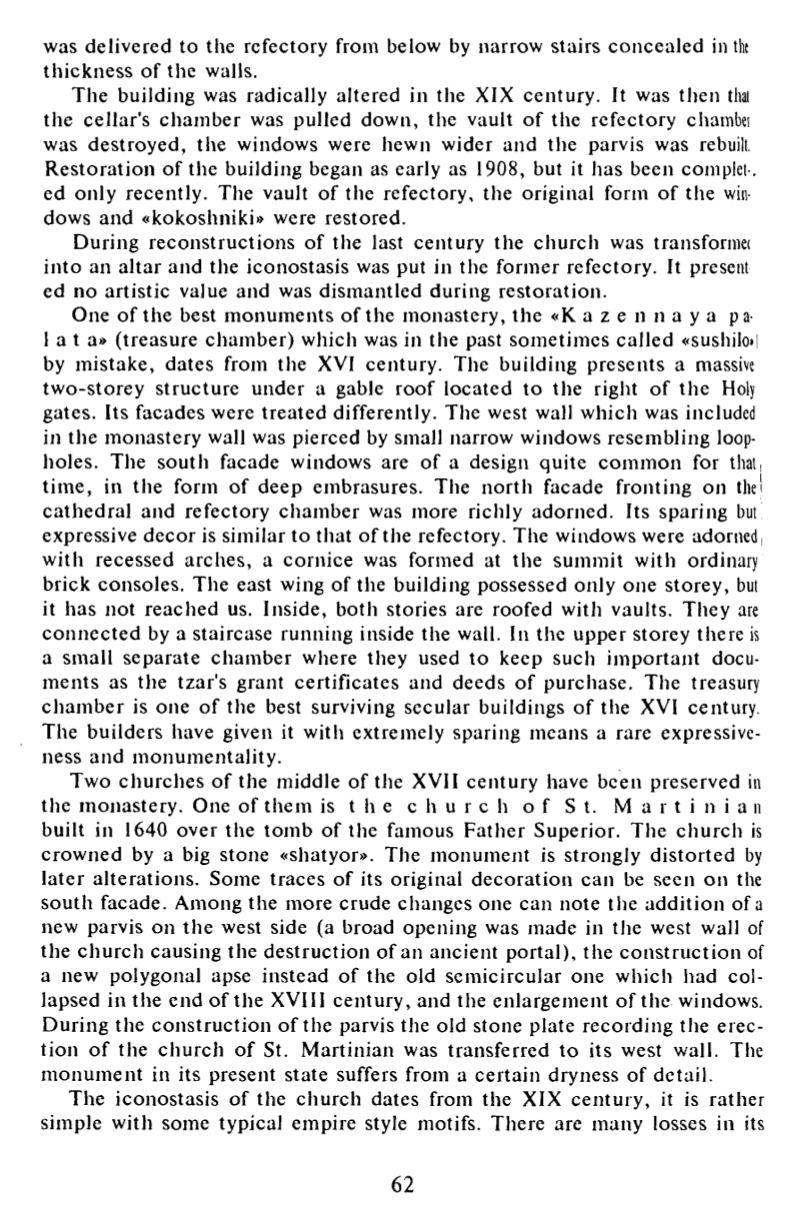

was delivered to the refectory from below by narrow stairs concealed in tht
thickness of the walls.
The building was radically altered in the XIX century. It was then that
the cellar's chamber was pulled down, the vault o f the refectory chambei
was destroyed, the windows were hewn wider and the parvis was rebuilt.
Restoration of the building began as early as 1908, but it has been complet-.
ed only recently. The vault o f the refectory, the original form o f the win
dows and «kokoshniki» were restored.
During reconstructions of the last century the church was transforms
into an altar and the iconostasis was put in the former refectory. It present
ed no artistic value and was dismantled during restoration.
One o f the best monuments of the monastery, the «К a z e
11
n a у a pa-
l a t a » (treasure chamber) which was in the past sometimes called «sushilo*!
by mistake, dates from the XVI century. The building presents a massive
two-storey structure under a gable roof located to the right o f the Holy
gates. Its facades were treated differently. The west wall which was included
in the monastery wall was pierced by small narrow windows resembling loop
holes. The south facade windows are of a design quite common for that,
time, in the form of deep embrasures. The north facade fronting
011
the'
cathedral and refectory chamber was more richly adorned. Its sparing but
expressive decor is similar to that of the refectory. The windows were adorned
with recessed arches, a cornice was formed at the summit with ordinary
brick consoles. The east wing of the building possessed only one storey, but
it has not reached us. Inside, both stories are roofed with vaults. They are
connec ted by a staircase running inside the wall. In the upper storey there is
a small separate chamber where they used to keep such important docu
ments as the tzar's grant certificates and deeds o f purchase. The treasury
chambe r is one o f the best surviving secular buildings o f the XVI century.
The builders have given it with extremely sparing means a rare expressive
ness and monumentality.
Two churches o f the middle of the XVII century have been preserved in
the monastery. One of them is t h e c h u r c h o f St . M a
1
t i n i a
11
built in 1640 over the tomb of the famous Father Superior. The chu rch is
crowned by a big stone «shatyor». The monument is strongly d istorted by
later alterations. Some traces of its original decoration can be seen on the
south facade. Among the more crude changes one can note the add ition of a
new parvis
011
the west side (a broad opening was made in the west wall of
the chu rch causing the destruction of an ancient portal), the cons truc tion of
a new polygonal apse instead o f the old semicircular one which had col
lapsed in the end o f the XVIII century, and the enlargement of the windows.
During the construction o f the parvis the old stone plate recording the e rec
tion o f the chu rch o f St. Martinian was transferred to its west wall. The
monumen t in its present state suffers from a certain dryness of detail.
The iconostasis of the church dates from the XIX century, it is rather
simple with some typical empire style motifs. There are many losses in its
62















